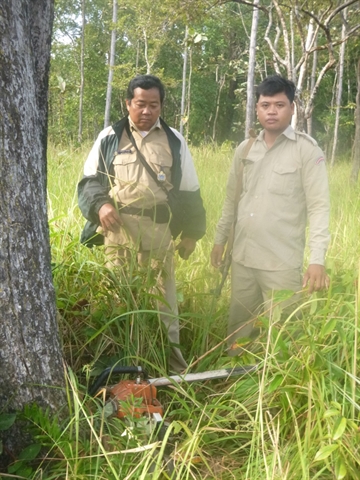Last Saturday, in the Preah Vihear forest reserve in northern Cambodia, forest ranger Sieng Darong and police officer Sab Yoh confiscated some chainsaws from an illegal logging site. For them, it was routine work. Both had patrolled Cambodian forests for years, and were familiar with the country’s epidemic of illegal logging and wildlife poaching.
That night, they set up camp with two colleagues, planning to continue their patrol the following day. While they slept, an intruder armed with a high-powered weapon killed them both. Darong, 47, was survived by his wife and two daughters; Yoh, 28, is survived by his wife and daughter. One of their colleagues escaped, and the other is wounded but recovering.
Cambodia has one of the worst deforestation rates in the world: over the last 45 years, primary rainforest cover has dropped from 70 percent to 3 percent, and the loss is accelerating. During the country’s civil war, which began in 1970 and finally sputtered to an end in 1995, the warring factions—including the genocidal Khmer Rouge—supported themselves with illegal timber sales. In recent years, government corruption and foreign demand for rosewood and other rare trees have sustained the illicit trade. The community activists and forest rangers trying to save the country’s remaining trees face not only political opposition but also, quite literally, a guerrilla war.
In the spring of 2012, Cambodian community forest activist Chut Wutty was killed in front of two journalists as he drove away from a military police checkpoint. Less than five months later, environmental journalist Hang Serei Oudom, who had reported on illegal logging, was found murdered in the trunk of his car; two weeks later, another environmental journalist, Ek Sokunthy, was attacked in his home by three assailants and severely beaten with a pistol and a stick.
After Chut Wutty’s murder—and the speedy dismissal of the case by a Cambodian court—Wutty’s former colleagues at the international NGO Global Witness began to document the terrible cost borne by environmental activists around the world. Their 2014 report found that 711 activists, journalists and community members had been killed in the last decade as a result of their work on land, forest, and water issues. (The figure represents the cases confirmed by Global Witness. The actual number of deaths is likely far higher.)
Global Witness’ follow-up investigation, released this spring, reported that the death toll had increased to 908. Brazil alone had lost 448 activists to documented killings since 2002; Honduras had lost 109; the small and close-knit citizenry of Cambodia had lost 10. On Saturday, with the deaths of Darong and Yoh, that number rose to 12.
This week, we’re observing Veterans’ Day in the U.S. Many of us are also, in the wake of the Keystone XL pipeline denial, reflecting on the nature and purpose of environmental activism. It’s a good time to remember that in many parts of the world, environmental activists are veterans, too. They’re fighting an invisible war on behalf of us all—and too many are paying the ultimate price.
Top photo: forest ranger Sieng Darong and police officer Sab Yoh. Photo courtesy of the Wildlife Conservation Society.

One thought on “Lives on the Line”
Comments are closed.